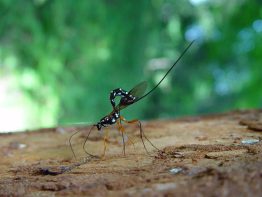Ichneumon Wasp
 Order:
Order:
Hymenoptera (bees, wasps, sawflies, ants and velvet ants)
Superfamily: Ichneumonidae (ichneumonids or ichneumon wasps)
How to identify:
As with most insects, ichneumonids have six legs and four wings. They are small (0.11-1.5 inch) and slender, with a thin section at the beginning of the abdomen. With thousands of species in the family, there is great variety in size and color. The “stinger” is, in fact, an ovipositor (with which it lays eggs) used to locate larvae through tree bark and inject their eggs on the prey larvae.
Advanced ID: The pronotum is more or less triangular, extending to tegula. Antennae are threadlike, with 16 or more segments. Hind trochanters are two-segmented. Ovipositor is in front of the apex of the abdomen, often long (even longer than the body) and non retractable. Venation is usually normal. Except for one subfamily, front wings do not have a costal cell (Borror & White, 1998).
Ecology
Metamorphosis Type: Complete metamorphosis: egg, larva, pupa, adult. Larvae often look very different from adults.
Geographic Range: Every continent except Antarctica.
Habitat: Most terrestrial habitats, such as woodlands, grasslands, gardens, agricultural fields, etc. Larvae live inside other insects.
Larvae: Parasitoids (adults lay eggs on other insect larvae, which the wasp larvae consume live)
Adults: Herbivore: consumes plant nectar.
Food: As adults, ichneumonids drink water and flower nectar. As larvae, different species of ichneumonid wasp specialize on their host (e.g., beetles, butterflies, ants, bees, wasps, flies, spiders, etc.). The mother ichneumonid paralyzes the host with a sting, often taking the host back to a burrow she has created for her young. She then lays an egg on the host. When the larvae hatches, it eats the still-living paralyzed host, leading to a slow and painful death as the ichneumonid larvae consumes the host from the inside out, leaving the most vital organs for last to ensure freshness (University of Wisconsin, 2021).
Why should we care?
Human Uses: Ichneumonids are beneficial in agriculture as they help to control many important insect pest populations (e.g., tomato hornworms, boll weevils, and wood borers) (Missouri Department of Conservation, 2008).
Conservation Status: At the family level, ichneumonids are not currently considered endangered; however, at least one species is endangered. Furthermore, they are susceptible to insecticides, which reduce their populations. We can help protect these important insects by purchasing organic food or food from farmers who operate their farms using IPM (Integrated Pest Management) techniques. We can also plant ”pollinator gardens” of native plants, which support pollinators and ichneumonids (IUCN Red List of Threatened Species, 2021).
Did you know?
- Ichneumonidae are the largest family of known insects, with over 5,000 species in North America and 60,000-100,000 species worldwide. (Missouri Department of Conservation, 2008)
- Ichneumonids lay their eggs on the larvae (and rarely the egg sacs) of other insects or spiders. Sometimes these larvae are found deep inside living or dead trees, so the ichneumonid mother uses her antennae to detect movement inside the tree. She then drills her ovipositor precisely into these larvae. Long “tailed” ichneumonids cannot sting humans at all; short “tailed” ichneumonids can pierce the skin of a human, but does not inject any venom (University of Wisconsin, 2008).
Images Cited
Photo 1: Boris Hrasovec. 2003. Creative Commons License | Link
Photo 2: David Cappaert. 2009. Creative Commons License | Link
Photo 3: Natasha Wright. 2007. Creative Commons License | Link
Photo 4: Allenwoodliffe. 2022. Creative Commons License | Link
Photo 5: Beatriz Moisset. 2012. Creative Commons License | Link
Photo 6: Syrio. 2018. Creative Commons License | Link
Photo 7: Paul Andrews. 2007. Creative Commons License | Link
Researcher’s Biography
Kimberly Ojeda-Celaya
Completed this research within Dr. Shelly Thomas’ Entomology course
Suggested Citation:
Ojeda-Celaya, Kimberly. (2022). Ichneumon Wasp. Rowan University Arboretum. https://arboretum.rowan.edu/learn/explore-insects/ichneumon-wasp/
Questions to Explore
- How do ichneumon wasps contribute to maintaining ecosystem services such as nutrient cycling, pollination, and decomposition?
- How has the ichneumon wasp species evolved to exploit different hosts, and what are the evolutionary drivers behind these changes?
- How can ichneumon wasps be used as bioindicators of pollution or environmental change?
Citations
Borror, D. J., & White, R. E. (1998). A field guide to the insects of America north of Mexico, 2nd edition. Boston: Houghton Mifflin Harcourt.
College of Letters & Science Field Station. (2008). Ichneumon Wasp (Family Ichneumonidae). University of Wisconsin. Accessed on 29 November 2022. | Link
College of Letters & Science Field Station. (2021). Therion Wasp. University of Wisconsin. Accessed on 01 December 2022. | Link
Missouri Department of Conservation. (n.d.). Ichneumon wasps. Accessed on 01 December 2022. | Link
Nunes, R. & Borges, P.A.V. 2021. Syrphoctonus morio. The IUCN Red List of Threatened Species 2021: e.T124928575A124930881. Accessed on 07 December 2022.
| Link






